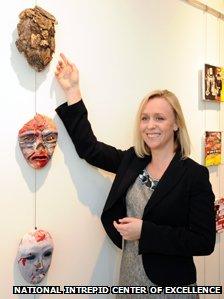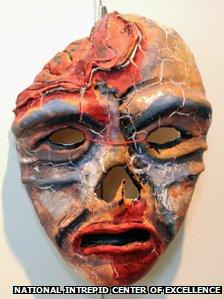US hopes music and art can sooth traumatised soldiers
- Published

Lt Col Capps says putting memories into writing renders them less threatening and less frightening
The US wars in Iraq and Afghanistan etched scenes of violence and death into the memories of hundreds of thousands of soldiers. Now, military researchers are exploring whether writing, art and music can sooth veterans seared by wartime trauma.
Lt Col Ron Capps has no doubt that writing about his wartime experiences saved his life - and now he has the chance to help provide the scientific proof.
Over 25 years in the army and a career in the foreign service, he witnessed five different wars. He served in Rwanda, Kosovo and Afghanistan, where he was treated for post traumatic stress disorder.
He went to Iraq, and later in Darfur, Sudan, he attempted suicide.
"My medications weren't working and I was self-medicating with whatever I could find lying around," he says.
"I was having a lot of problems and one of the things I found that really helped me was writing. I wrote my way home."
Anatomy of the brain

Ms Walker says making art lifts a burden from the vets' shoulders
Now Lt Col Capps is running creative writing workshops at the National Intrepid Center of Excellence (NICoE), a new military medical facility at Walter Reed National Military Medical Center in Bethesda, Maryland, that offers holistic healing for brain trauma and other invisible wounds of war.
And for the first time, neurologists there will attempt to discover how creative writing and other arts therapies physically affect the brain.
"We have in this facility the technology to look in great detail at the anatomy of the brain and the function of the brain," says NICoE Director Dr James Kelly.
"No other location in the country has all this in one place."
Dr Kelly's team is now creating a series of tests to monitor the brain's metabolism and magnetic impulses as patients are exposed to writing, painting and music.
Front lines
The results could give doctors new insight into how arts therapies help patients with traumatic brain injuries and psychological conditions.
The writing project is an extension of the award-winning programme Operation Homecoming, which was created by the National Endowment for the Arts (NEA) to encourage US troops and their families to write about life on the front lines.

The mask represents an Iraqi man shot in the head and killed
"When we're faced with a really traumatic memory our brain has to make a decision: 'What do I do with this memory, where does it go, where do I put it?'" says Lt Col Capps.
"It gets pushed aside because your mind doesn't know how to deal with it. By accessing that memory using a creative art you distance yourself. You're able to create something tangible and you can take it and shape it in a different way.
"And by telling that story through writing or art or music or dance or any of these expressive arts, by telling that story over and over again, it becomes less threatening, less dangerous and less of a problem. That's what's worked for me. You just tell it until it doesn't scare you anymore."
The therapeutic benefits of Operation Homecoming have been so far anecdotal. The NICoE programme is the first time its theory will be clinically tested.
"This is a place where a lot of basic research is done and data is collected," says NEA Chairman Rocco Landesman.
"We're going to learn a lot about the role of art in the brain and thinking as we see how engagement with art changes the brain physiologically.
"At the NEA we're obsessed with how art actually works, how it works on human beings, how it works in the brain - and I think this is going to be a laboratory for that."
Frozen image
The military has already embraced the arts as an important part of therapy and healing. The NICoE has a music room and art studio where one wall displays a series of face masks designed by patients trying to process the trauma of conflict.
One represents an Iraqi man who was shot in the head. His brain was exposed by the wound and although he was still walking and talking, the American troops and medics were unable to save his life. The veteran who created the mask said the image was frozen in his mind.
"This was his way of expressing what that looked like to him and to be able to externalise it and then be able to process it outside his memory," says art therapist Melissa Walker.
She says such work often triggers what she calls the "Aha!" moment.
"I see a lot of breakthroughs where service members have never talked about something before and then they create it," Ms Walker says.
"They'll look up and express what they've created and something is different about them. Something has been lifted off their shoulders."
'The real world'
The NICoE research will help bolster the NEA's broader mission to establish the arts as a fundamental part of human development at every age. It could also help justify public funding at a time when Congress is looking at ways to cut budgets.
And the data gathered by the military will add to a growing body of neuroscience showing strong connections between arts learning and cognitive development in children, better outcomes for at-risk teenagers and improved brain function and quality of life among older adults.
"Any intersection of the arts and the real world helps us make the case that it's not just about going to the opera in New York City," says Mr Landesman.
"There are aspects of people's everyday lives that are touched by the arts that are very important."
- Published18 December 2011
- Published18 December 2011